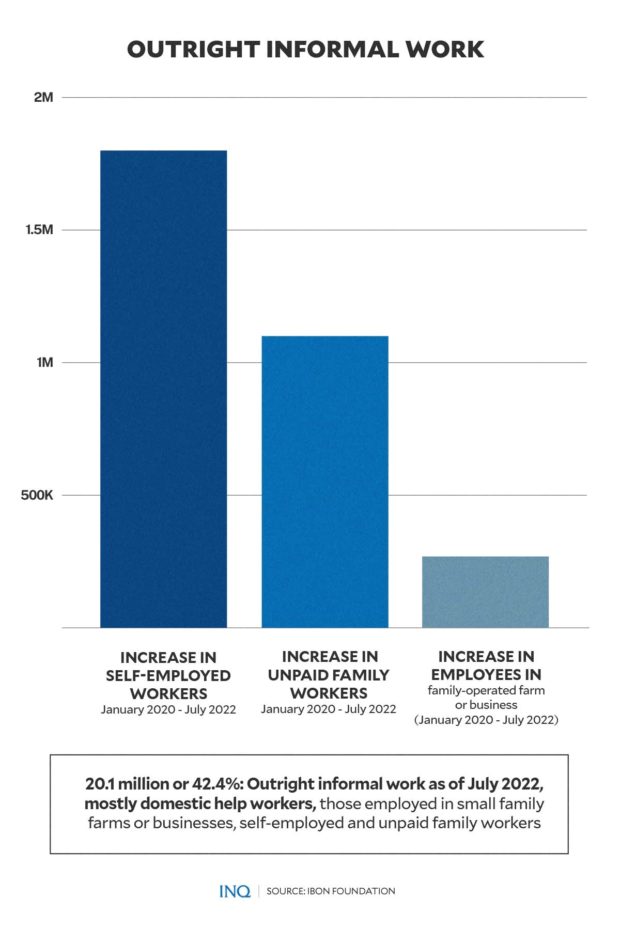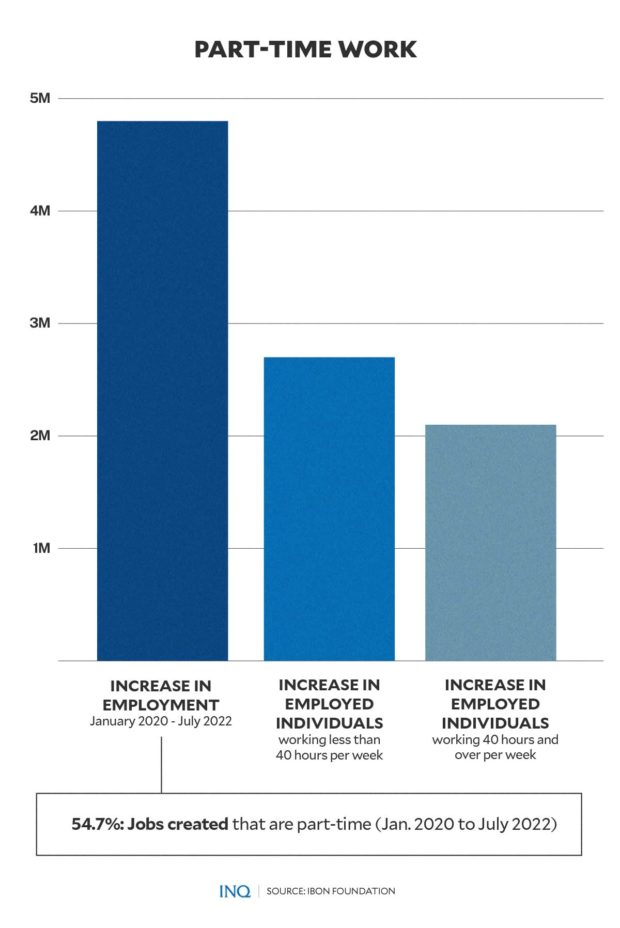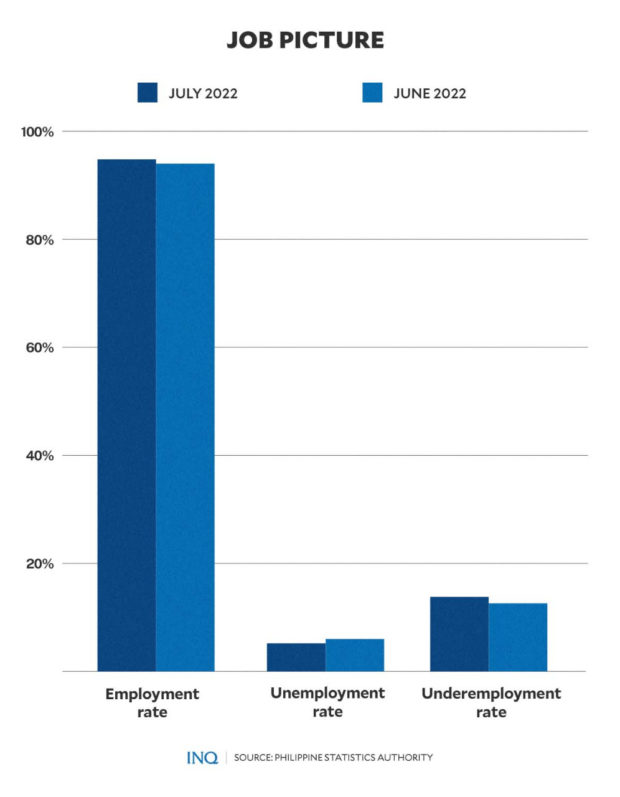As job count includes short-term work, gov’t urged to continue ‘ayuda’
MANILA, Philippines—From a record-high 17.6 percent in April 2020, the unemployment rate, according to the Philippine Statistics Authority (PSA), fell to 5.2 percent in July 2022, the lowest since the start of the COVID-19 crisis.
READ: Unemployment now at lowest level since start of pandemic
Back in April 2020, when strict lockdowns were imposed by the government, 7.3 million Filipinos had no work. But last July, the number of jobless individuals declined to 2.60 million, even lower than the 2.76 million in April this year.
The PSA likewise highlighted on Thursday (Sept. 8) the 800,000 increase in employed Filipinos—47.4 million (94.8 percent) in July 2022 from 46.6 million (94 percent) in June 2022.
But despite this, the think tank Ibon Foundation stressed that “more and more Filipinos are forced to make do with informal work given the lack of better jobs” in the Philippines.
This, as the 13.8 percent (6.54 million) underemployment rate in July 2022, while lower than the 20.9 percent (8.77 million) in July 2021, was higher than the 12.6 percent (5.89 million) in June 2022.
Ibon Foundation said this was the reason that it is best to compare the July 2022 labor data with the figures before the lockdowns that were imposed by the government to mitigate the spread of SARS-CoV2, the virus that causes COVID-19.
RELATED STORY: Unemployment easing? SWS survey says 1 in 3 Filipinos jobless
“[This] gives a better picture of the country’s jobs situation and shows that most of the jobs created are [of] poor quality,” it said, stressing that most Filipinos do not have the chance to look for better work and have to settle for what is available.
Working less
Comparing data in July 2022 with the figures in January 2020, the number of employed Filipinos grew by 4.8 million from 42.5 million, however, the think tank noted that by hours worked, 54.7 percent of the jobs created were part-time.
It said those working less than 40 hours increased by 2.7 million from 13.4 million in January 2020 to 16.1 million in July 2022. Those “with a job, not at work” grew by 141,000 to 474,000.
Ibon Foundation stressed that while full-time workers—those working 40 hours and over—increased by 2.1 million, “[it] was not enough to offset the number of part-time workers.
It said by class of worker, the number of Filipinos in jobs that tend to be informal or irregular has likewise increased as the number of self-employed workers grew by 1.8 million from 11.1 million in January 2020 to almost 13 million in July 2022.
The number of unpaid family workers also grew by 1.1 million from 2.6 million to 3.7 million, while employers in family-operated farm or business grew by 269,000 from 1 million to 1.3 million.
Based on data from the PSA, the average weekly hours spent on work by an employed person in July 2022 was 40.5 hours, while visible underemployment rate—the proportion of employed individuals working less than 40 hours a week—was 9 percent.
RELATED STORY: High underemployment smudges gov’t jobs picture
Informal work in PH
Ibon Foundation estimated that 20.1 million—or 42.4 percent—of jobs as of July 2022 are “outright informal work made up of domestic help, those employed in small family farms or businesses, self-employed and unpaid family workers”.
“This is an increase of 3.4 million since January 2020 and does not even cover informal workers in private establishments,” it said.
READ: Jobs for Filipinos: Dark past and present, uncertain future
It likewise stressed that a comparison between July 2020 and pre-crisis July 2019 labor data reflected the same, saying that employment increased by 4.9 million from 42.5 million in this period.
But by hours worked, those working less than 40 hours grew by 2.8 million from 13.3 million in July 2019. This means that almost 57 percent of the jobs created were part-time.
This, as those with a job but not at work increased by 145,000 from 328,000, as well as full-time workers by almost 2 million from 28.9 million, with an estimated 2.8 million increase in the number of outright informal workers.
It said by class of worker from July 2019 to July 2022, there were also increases in the number of self-employed workers (by 1.4 million), unpaid family workers (by 1.1 million) and employed in own family farm or business (by 82,000).
High jobless rate seen in 2023
Last month, Socioeconomic Planning Undersecretary Rosemarie Edillon told the INQUIRER that as an estimated 1.5 million Filipinos are expected to join the labor force next year, unemployment is seen to worsen.
READ: Expect high jobless rate as 1.5M join labor force in 2023
This, as the 1.5 million is more than double the normal volume of new entrants of 600,000 in previous years, with Edillon saying that this would exceed the number of jobs expected to be made available as the economy reopened.
She said the National Economic and Development Authority (Neda) was already bracing for a possibly higher unemployment rate in 2023 as more K-12 graduates were also set to join the pool of Filipinos looking for work.
In July 2022, the labor force participation rate—the proportion of the working-age population that is either working or actively looking for work—was 62.5 percent, translating to 49.99 million Filipinos.
“This, notwithstanding, we note that between 2018 and 2019, there was an increase in the labor force by 1.3 million, yet the unemployment rate was a low of 5.1 percent because of the sustained growth which encouraged more investments,” Edillon said.
She explained that the expected increase would be mainly because of the economic recovery and the “stabilization of the K-12 stream,” which would lead more Filipinos, including the youth and the elderly, to look for jobs.
‘Could get worse’
Ibon Foundation stressed that the jobs situation could get worse if the government persists in slashing funds for ayuda and social assistance programs in the 2023 national budget.
It said despite the increase in the number of informal workers, the government has proposed cuts to important worker and livelihood ayuda resources for the Tulong Panghanapbuhay sa Ating Disadvantaged or Displaced Workers (by P10.9 billion).
There were also cuts in the funds for the Micro, Small and Medium Enterprises Development Program (P1.2 billion), the Small Business Corporation (by P500 million), and the Agricultural Competitiveness Enhancement Fund (by P115.3 million).
It stressed that the government likewise made cuts to the resources of the Department of Labor and Employment (DOLE), especially for its key programs that facilitate employment and protection of workers.
Ibon Foundation said despite the creation of the Department of Migrant Workers (DMW), the labor budget, which is composed of the DOLE and DMW funds, is still limited—P51.3 billion in 2022 to a proposed P41.4 billion in 2023.
For instance, allocations for the DOLE-Office of the Secretary were cut by 11 billion, highly because of the cut in the Employment Facilitation Program (by P122.3 million) and the Workers Protection and Welfare Program (by P11.1 billion).
Economy ‘far from recovered’
Ibon Foundation said the worsening jobs crisis, which is coupled with increasing poverty and high prices of basic commodities, is a sign that the economy has not yet recovered.
READ: As Duterte stepped down, more Filipinos tighten belts to make ends
It stressed that “instead of being dismissive and insensitive,” the government “should not slash but inject even more 2023 budget funds into ayuda and small business and producer support as well as important labor programs that will cushion vulnerable Filipino workers and their families and help them and the economy recover”.
The PSA said 19.99 million Filipinos (3.50 million families) were considered poor last year as poverty incidence rose to 18.1 percent from 16.7 percent—P17.67 million (3 million families)—in 2018.
It said the poverty threshold, which is the minimum income that a family of five needs to meet basic food and non-food needs, was P12,030, 11.8 percent higher than P10,756 in 2018.
Last Tuesday (Sept. 6), the PSA said the inflation rate in the Philippines slowed down for the first time in six months to 6.3 percent in August from the 6.4 percent in the previous month.
READ: PH inflation eased to 6.3% in August
National Statistician Dennis Mapa said the slight easing was mainly because of the slower increases in transport fares and in the prices of food and non-alcoholic beverages, especially vegetables, meat and fish.
However, Ibon Foundation said the lower August 2022 inflation print does not mean that prices of basic goods and services have become more affordable.
This, as transport (14.6 percent) and food and alcoholic beverages (6.9 percent), while lower compared to July 2022, are still much higher compared to the previous year when transport inflation was at 7 percent and that of food and alcoholic beverages was at 5.5 percent.
RELATED STORY: Closer look at PH jobs picture shows little stable employment
TSB




